
10 Feb-10 Mar 2019 and 10 Feb-9 Mar 2020
Rishikesh, India
India’s unemployment rate of about 7% is lower than France’s and slightly higher than Canada’s. The good news is that extreme poverty in India, defined as living on less than $2 per day, is declining at the rate of about forty-four people per minute. Forty-four people per minute in India are moving beyond extreme poverty! This is such good news. Extreme poverty around the world is also declining according to the World Poverty Clock where you can watch the numbers go down.
There’s a massive middle class in India now who live in relative prosperity and comfort. Nevertheless there are many people who do backbreaking construction work for ten or more hours a day. They often live in very minimal temporary housing that’s basically camping for months on end, cooking simple meals over a small fire, and washing in the river or at a communal tap or pump.
Then there are people like Mohan and Lakshman, the servers at Flavours, one of our favourite restaurants in Rishikesh. They work fifteen-hour days and seem always cheerful. They are both so open, so gracious. We are welcomed like family. Mohan has shared with us that he follows the same spiritual teacher that we do. He’s not just the cheerful server; clearly there is depth here, an inner seeking, a gravitas beyond outward appearances. This is true of so many people in India. How else could this impossible country work?
Many years ago we did a tour of Chowri Bazar, a huge wholesale market area in New Delhi. Our tour guide told us how much the chai wallahs make. It was a surprisingly large amount that I suspect only applies to the chai wallahs of Chowri Bazar. More than 1.5 million people pass through the area every day, all of them wanting chai. But what I remember most is him saying that they work every day and that they don’t take vacations. That simply wouldn’t occur to them. Taking vacations is not part of the Indian culture, particularly for working-class people, yet statistics show that even most middle-class people don’t take their allotted vacation time for various reasons. India ranks fifth in the world for unused vacation days.
We walk around Rishikesh every day. Like any other place we see people at work – the daily grind, or the daily occupation. Life unfolding. For many people here life is tough. Really tough. Tougher than I’ve ever had to face so I can’t presume to know anything about it other than I think I would break under the unrelenting weight of it. And no doubt some do. But many don’t. Like most people they toil away surrendering to the inevitability of their life. This surrendering is a part of the Indian psyche, and is a part of what makes the country work despite so many reasons why it shouldn’t. Should it be different? Could it be better? That’s not my place to say. It is what it is. India shows itself in all its confounding colours.
From Camille Framroze: A part of me felt as though I ought to give thanks after every journey through Mumbai’s traffic that I survived unscathed. We all routinely confront the same fork in the road, over and over again, everyday: fight the bedlam, make sense of the disorder—or surrender to it. In my surrender to India, however, I remained acutely aware that I had the luxury of choosing it. Most do not. I passed by streams that had turned a milky green, dogs and children playing in scattered trash, villages without electricity. I met a 12-year old boy who told me he wanted to be a doctor and in the same breath added cheerfully that of course that was not possible. India’s poverty is so abject and so pervasive that it has been twisted into a kind of normal. The surrender that allows us to share our home in relative peace is the same resignation that inhibits so many from demanding more. That I, with my hiking boots and harem pants and broken Hindi, was met with warmth rather than contempt both filled and broke my heart.
Mine too.
Sitting in the Shambala Cafe, another of our favourite restaurants, Don asks our server how he is. Happy. Always happy. It is God’s gift. he replies with a wide smile. This acceptance, this surrendering to what is, as it is, makes the lucky happy, and the not so lucky at least able to endure. Don quietly tells me that interactions such as he just had with the server, make him love India all over again. Me too.
Here then is my visual ode to the Indian worker:
The launderers.
The bag lady.
The chai wallahs.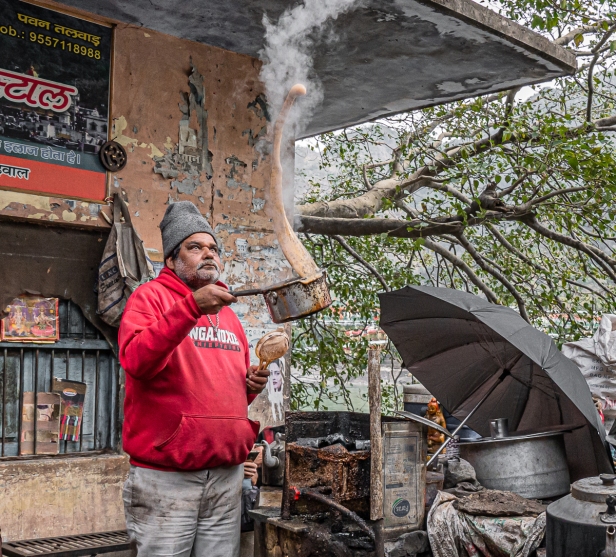

Chai wallahs, proud of their heritage and secret recipes, brew their chai fresh all day using tea, ginger, cardamom, cinnamon, cloves, black pepper, and many other spices. And of course milk, and bags of sugar. Throughout India the chai wallahs get the population caffeinated one small cup at a time, a unifying force in a wildly diverse country.

I usually warn people who’ve never been to India: India is filthy. Not the people, who as far as I can tell, wash every bit as often as people of any other country. It’s that for the most part there are no sidewalks, or only small ones outside each business. Between the business front and the road is a gulf of gravelly dirt. It is hot and dry for many months of the year and the dirt turns to powder, and wind and the passing traffic, both foot and vehicular, disturbs it. It rises swirling up in a gauzy haze and gently falls down sprinkling a fine dust over everything indoors and out. Unfortunately it’s not fairy dust. The fairy dust comes from a deep spirituality and faith that pervades the land giving everyone an injection of at worst the ability to tolerate, at best a contagious joy. There is a raw realness about this country; India has not been paved over.
Every day the dust and debris is swept up either by the home or business owner or by street sweepers who collect it in big metal wheelbarrows and wheel it away to the garbage dump. Sometimes the cows help with recycling.
Every morning the dust and debris from the day before is swept off the ghats by the river, only to have more return and be swept up the next day in an endless cycle. India’s dust keeps a lot of people employed.
The ghat sweeper.
There is a chain restaurant in India called Chotiwala. A choti, or sikha, is the small area of hair remaining on the back of a shaved head to help with connection to the divine. Thus the symbol for the restaurant chain is a cartoon-like image of a well-fed man with his choti gathered into a kind of spike sticking up from the back of his head. There are three Chotiwala restaurants in Rishikesh, two side-by-side, and a third across the river. At the entrance of each of the two that are side-by-side there is a man dressed in a traditional golden dhoti, each with a spiked choti and elaborate face make-up. The make-up is different each day, except one of the men always has a pink face. And there they sit all day. It is their employment. Sometimes Indian tourists stop to take a selfie with them. Otherwise they sit there, living symbols silently welcoming people into the restaurant. I worry about them getting skin cancer.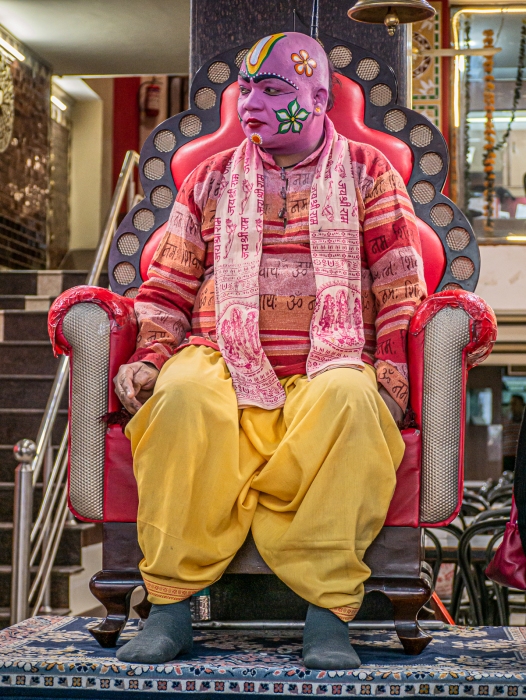

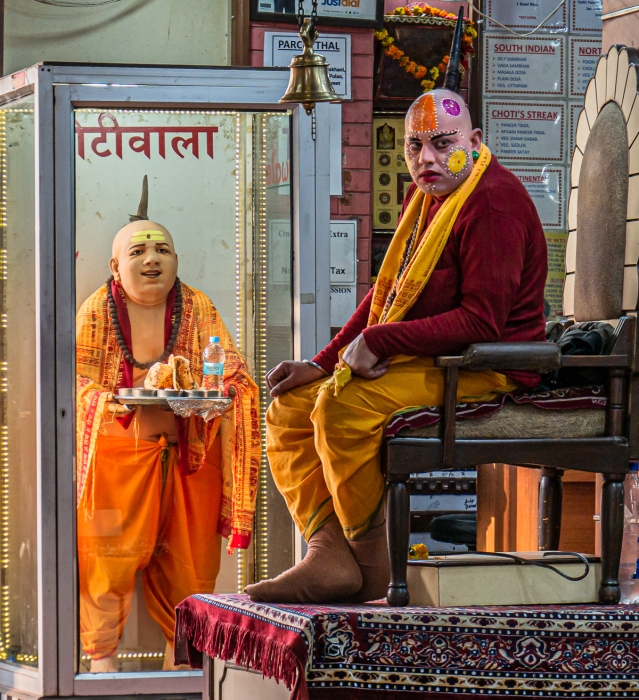

On our daily walk last year we passed by a construction site next to the river. There were people hauling stones around and laying them in straight rows.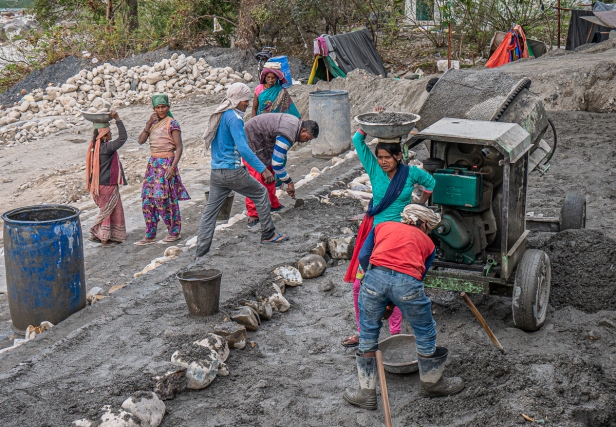
There were women, in saris and flip flops, delivering rocks one by one.
There was a cement mixer powered by a generator and there were several people, both men and women, who were carrying pans of sand on their heads to the cement mixer, back and forth in an endless loop feeding the machine.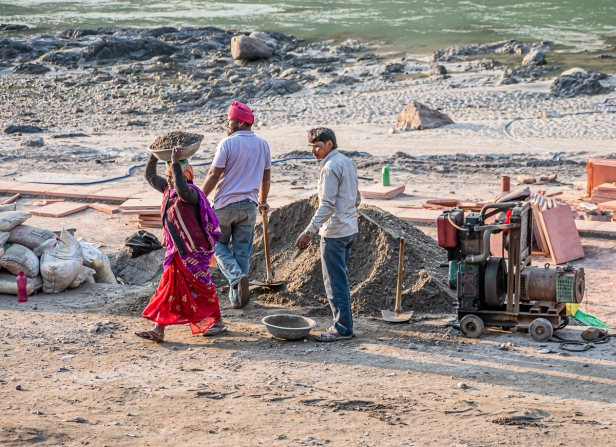

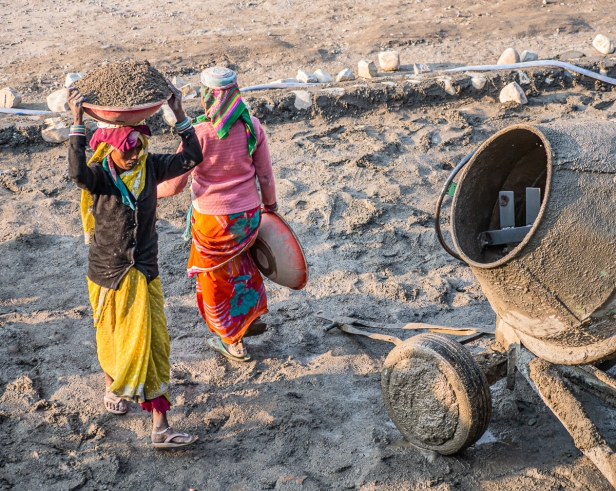
And then the cement was poured on top of the rows of rocks. Eventually we figured out they were building a new ghat. And that this was their temporary housing right by the construction site.
This year we arrive to find, sure enough, the tents are gone, and there is a shiny new ghat where once there had been only sand and gravel.
The dosa cook.
The itinerant musicians.


The electrician. No hard hat, no safety harness, no boots.
Horses and donkeys are used for hauling sand to, and from, construction sites. Most mornings we’d see them down by the river being loaded up with gravel and then marched promptly off to one construction site or another.
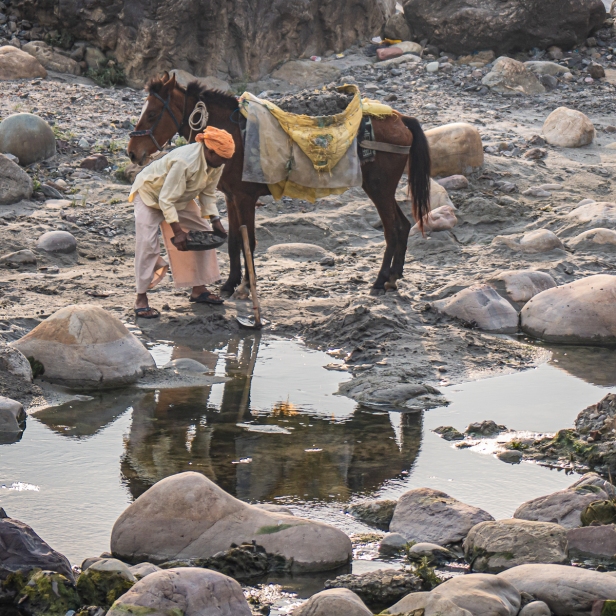
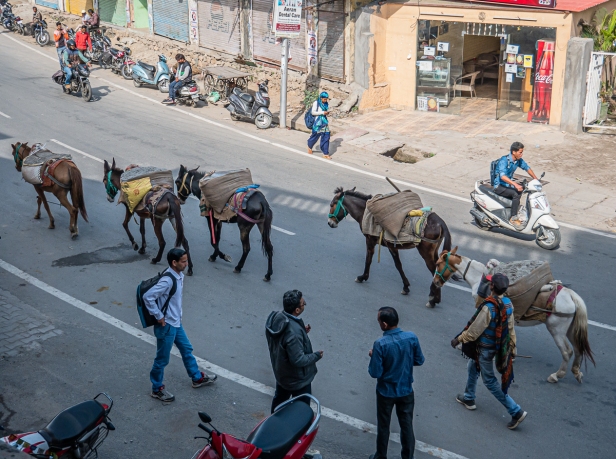
This woman has been collecting feed for her milk cows. These leaves apparently make the milk taste sweeter.
Today we met Hanuman the Monkey God. We’d seen him on our walks the past few days, but this morning we met him. He blessed us with an orange bindi, and tied red and yellow string around our wrists while saying a prayer. I am the monkey god! he said importantly, and followed the words with raising one “paw” and screeching like a monkey. Really, it was exactly like a monkey. It was mildly scary how right he got it. I said to him This is your job isn’t it? He smiled brightly and agreed, saying proudly Yes, this is my job clearly pleased to have his occupation recognised in this way, and then he posed nicely for me. I said You just made this up, this job for your self! Yes he agreed, pleased that I could see what he had created. So cool! Then he charged us 100 rupees each for the photographs, the blessing, the prayer, and the conversation, which we happily paid.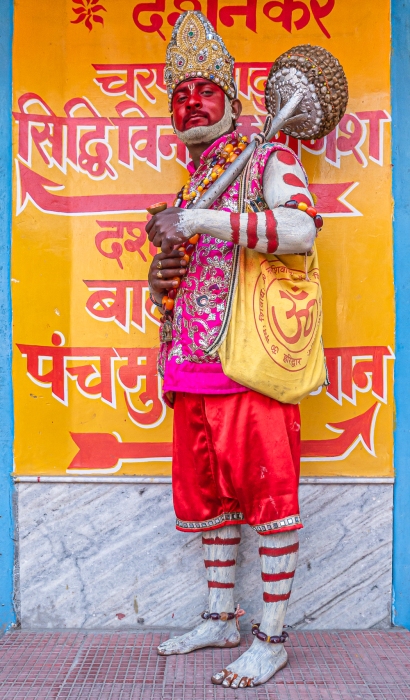
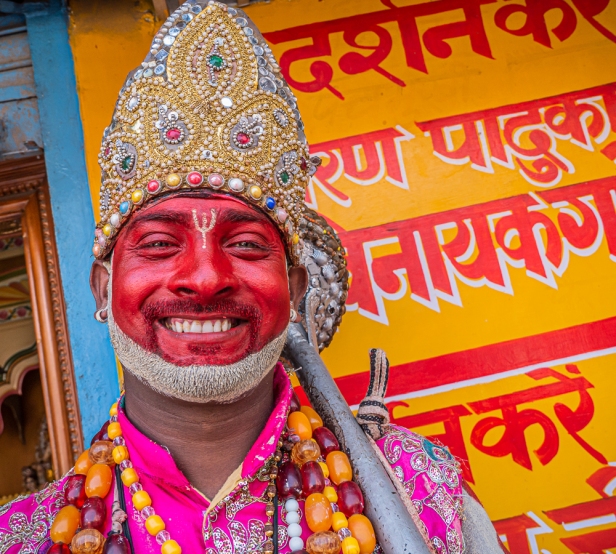
And lastly, the beggars. On our first visit to India, back in 2012 I wrote this: I have been aware for a long time of a small but persistent inner contraction each time I see a beggar, as if I somehow have to arm myself against them. Then one day last week I suddenly could see it in a whole new light.
It appears that we have choices in life. According to the choices made some people sink, some swim. Some thrive, some barely survive. Some make good choices, others, not so much. But where we apparently don’t have a choice is the circumstances we are born into, and the circumstances we are born into have a huge impact on the range of choices available to us later in life. So according to our circumstances, when we grow up hopefully we get the best kind of job we can. It suddenly occurred to me that beggars spend all day asking people for money. That’s their job. That’s the best they are able to come up with given their circumstances. Of course fund-raisers also have the same job – asking people for money, usually including their own salary, but it’s all dressed up in a much more attractive and socially acceptable package. Anyway I suddenly could see begging in a completely different light. These people are just doing their job. I was also faced with what I knew – that for me to give ten rupees to every beggar I saw every day would be nothing for me. Nothing. Ten rupees is twenty cents. Why on earth was I being so tight? So now when I go out I carry a pocket full of ten rupee notes and give one to anyone who asks. Don calls it my Lady Bountiful money. It feels great.
We’ve continued doing this in Rishikesh. Like the street vendors, the beggars have their spot and since we walk more or less the same route every day we support the same people. A young mother with such a heart-breaking depth of sadness and desperation in her eyes that I can hardly bare to look contrasts with a man who has lost a leg. When Don asks him how he is he puts his hand on his heart, smiles widely, says he’s fine, and points to the sky, to God. All is well. And then there is the quite badly deformed woman who has a smile that outdoes the sun when she sees us. And this young mother with her sweet child, who, like most Indians, is delighted to be photographed.
They are all just doing their job, and we keep our pockets stuffed with ten rupee notes to honour them and their work.
I don’t know how else to be with the poverty here except to do as the locals do: accept it as it is. It is as much an integral part of India as chai and dust, the howling insistent traffic, and a sense of imminent calamity. I can’t change it, or fix it. I can only surrender to the fact of it, and live in gratitude for all the wealth Life has given me. I am humbled by India. And I have mad respect for the way people here make life work amid, and despite, the bedlam.
Next post: Ganga Aarti: the nightly Hindu ritual and prayer to the river.
All words and images by Alison Louise Armstrong unless otherwise noted
© Alison Louise Armstrong and Adventures in Wonderland – a pilgrimage of the heart, 2010-2020.

Wonderful street photography and an interesting report. The cow with the garbage really made me laugh as well. Excellent.
LikeLiked by 1 person
Thanks so much rabirius. I have other pics of cows getting into the garbage. And monkeys. It’s so completely normal here locals don’t even notice. Glad you enjoyed the post.
Alison
LikeLike
“Lady Bountiful money. It feels great.”…lovely and lively street photography indeed Alison…and you can feel your excitement in each capture…I know you love India…I can see it ☺️🤓 happy Monday ~ smiles Hedy
LikeLiked by 1 person
Thanks so much Hedy. I do love India. And I can’t even explain why really. It such a complex country that somehow amid the dirt and bedlam manages to grab your heart.
Alison
LikeLike
Some amazing pictures of the working people of India. This is, of course, the true India. Thanks so much for sharing.
LikeLiked by 1 person
Thanks so much Darlene. I really wanted to capture ordinary life here. For most people these days ordinary life is quite good fortunately. But it’s still India – crazy, almost a calamity, and yet so open and welcoming.
Alison
LikeLiked by 1 person
Powerful images Alison.
LikeLiked by 1 person
Thanks so much Cindy.
Alison
LikeLike
An extraordinary place, and I love seeing it through your eyes Alison 🤗💕
LikeLiked by 1 person
Thanks Jo. It is definitely an extraordinary place. I’m glad you’re enjoying my take on it.
Alison
LikeLiked by 1 person
Such a wise post, Alison. Your response to poverty restores dignity to all concerned: everyone doing what they can, however they can, and progress being made little by little on their own terms. As ever, there are some truly wonderful photos here.
LikeLiked by 1 person
Thanks so much Tish. I think anyone spending an extended time in India just has to find a way to come to terms with it. And yes, definitely progress is being made.
I do love street photography in India because for the most part people love to be photographed so there’s a real freedom about it.
Alison
LikeLiked by 1 person
Really thought provoking. I remember that ‘surrendering’ of Indian people. Once we were on a bus that broke down. Everyone got off, and waited, sitting on their haunches on the side of the road. No one asked anything. They just waited and accepted. We were tense, asking questions, wanting to know how long it would take. What a waste of time. That made such a big impression on me. And yet, sometimes this surrender can be a curse, curbing ambition, initiative. Maybe? Or maybe it’s just acceptance of the way it is. Like the boy who wanted to be a doctor. So many times I’ve been blown away by the intelligence and ‘get up and go’ spirit of people born into such difficult circumstances. I wonder what they could have achieved if their circumstances had been different. I guess we all have a responsibility to do the best with what we’ve been given. And because of that, I really like your thoughts on beggars. And I like the idea of lady bountiful money.
LikeLiked by 3 people
Thanks so much Tracey. I feel that my new approach to beggars, seeing them in a different light, was a kind of grace that was given to me. It has really helped how I deal with being here. The biggest thing about being Lady Bountiful is that I get to connect with the beggars as people – our shared humanity is recognized and honoured – instead of seeing them as something to avoid. It feels so much better.
I agree that the surrender can curb ambition. Much like that quote from Camille Framroze – the surrender is the same resignation that inhibits people from demanding more. So yes, I think it’s a two-edged sword. Still things are definitely improving here.
I also believe everyone is doing the best they can. It’s perhaps a pollyanna view that I’ve had roundly dismissed in the past, and yet it still lives in me. People do the best they can, even if it doesn’t look very wonderful.
Alison
LikeLike
I’d love to have a cup of that chai…yummm. Such a colourful post, lovely 🙂
LikeLiked by 1 person
Thanks so much amt. The chai is divine!
Alison
LikeLiked by 1 person
Every single time we have been in India, be it East or West, North or South, we are always struck by the workers. The fact that most construction sight use women is quite astounding and boggles the mind. Women in brightly colored saris balancing heavy loads on their heads, be it bricks or bags of sand. For sure a very hard life.
Your post is poignant and I do love how Don asks everyone how they are and I can tell that he asks in a way that indicates he is genuinely interested to know. Poverty and begging are hard to see and yet, see we must, as this is the reality for so much of the world. How we respond to it, does I agree make a difference. Even in big cities in the U.S. I always give what I can to homeless or people begging because I know that my $2 will mean so much more to them than it does to me. The only time I hesitate actually is when children are involved. This is a tough call… Many discourage this and prefer one gives to organized charities so that children are not exploited by the person who gets the money… Often times not the parent.
I found it so distressing seeing cows eating garbage and later read that it is a terrible problem. Cows are revered and yet, there is not enough food for them and many ingest plastic from garbage on the streets with bad outcomes.
I particularly like the first photo of the man dressed as Hanuman.
Peta
LikeLiked by 1 person
Thanks so much Peta. I confess I’ve given money to a woman with children and the older child also held out her hand and I gave her 10 rupees too. It’s so hard. The child was probably not more than 4 or 5 and already learning to beg. Also I read that it’s much harder for people to break out of the cycle of poverty in the rural areas and that it’s passed down through the generations. Here in Rishikesh it’s actually not that bad. It’s a relatively wealthy town and there are a lot of tourists here, both Indian and western who bring prosperity.
Oh the women in saris doing construction work! I was completely blown away by it the first time I saw it. I can’t imagine how they do it. And yes, a tough life.
It’s pretty apparent that most of the cows here are not very healthy. It’s very sad to see. Rishikesh, at least, has largely banned single use plastic so that’s something of an improvement, but still it’s clear the cows are not fed well.
Alison
LikeLike
This is one of your best posts ever. You’ve captured India in such a fundamental way that only those who love it can see. And you’ve honored the workers, the everyday folks who often radiate such inexplicable joy. Thanks.
I often struggle about giving to beggars. I’m more likely to do it when I’m not in the U.S. I was surprised how few I saw in India–a good sign I think. When it came to children in India, we usually gave them food. It seemed more likely that, even if they were being forced to beg, they’d be able to consume the food themselves. We saw many happy smiles on kids when we gave them oranges.
Thanks for this post!
LikeLike
Thanks so much Jane. The Indian people are so amazing – so much drudgery and hardship and yet they seem to more than endure, and to find joy even in the most difficult situations. I too find I’m less likely to give to beggars at home, though they’re not as prevalent as in India of course. Don and I will both give $5 to the one beggar who sometimes shows up in front of our local supermarket. I left a bunch of warm clothes and a quilt there for him too one day when he’d gone to get himself a cup of coffee. It such a small thing for me. We are so very blessed. And grateful.
Alison
LikeLike
Thank you for putting good effort into this missive from mysterious India. You’ve clarified so much. It’s heartrending and heartening at the same time. The chai wallah tossing his pot of chai is an exciting sight, another ordinary blessing in an impossible country. I’m moved. 🌿
LikeLiked by 1 person
Thank you so much Lynn. I really wanted to find a way to share what I’ve seen of real life here. In many ways it’s like any country – many levels of prosperity and happiness, with a unique India flavour. For all I know some of the people we give money to could be completely enlightened beings. That happens here. And conversely I hear wealthy people at satsang begging for help to find happiness.
Thanks re the chai wallah photo – it was fun to get that shot.
It is an impossible country. And grabs your heart because of it.
Alison
LikeLike
The usual “strategy” I hear about dealing with the massive amount of beggars is precisely what you wrote in 2012 about “arming” oneself. Most advice seems to be that you can’t possibly make a difference with so much poverty and that you’ll drive yourself crazy by selectively giving to beggars. I love the perspective you’ve discovered, both in terms of their circumstances and giving. You’re absolutely right that giving 10 rupees to beggars makes no difference in our life, but it can in their’s. It was a shock when I did the math: giving 10 rupees 200 times costs $40! I also love that Don asks them how they’re doing. I find it so heartbreaking when I’m faced with poverty/begging but I think your perspective will help me when we are in India.
This is a wonderful post and has given me much to think about. Your photos are stunning…the capture of the chai flying through the air is extraordinary. I never expected to see so many women involved in construction/heavy lifting.
LikeLiked by 1 person
Thank you so much Caroline. I was pretty pleased myself with the chai shot. It took a few goes to get it right (as I give silent thanks for digital photography) 🙂
We’ve seen women in saris and flip-flops doing manual labour all over India. They must be super strong, but no doubt it’s a really tough life.
Re the beggars – It felt like grace that I was given this way to see them. It really eased the burden for me. However I must warn you – we’ve only done it consistently in smaller towns (Turivannamalai and Rishikesh). I’m not sure how it would work in a big city like Mumbai or Delhi. I think there may just be too many of them, and there are a lot of street kids too so I think it would be good to be more careful in the big cities. Also in Tiruvannamalai and Rishikesh we lived there for several weeks and had regular walking routes so we’d see the same people almost every day. If we’d run out of 10 rupee notes it was never a problem because we’d already established a human to human connection.That’s actually what I quickly came to value most about it.
Alison
LikeLike
Such a thoughtful post. I’ve not been to India, but I’ve been to many developing countries that have stirred the same kind of thoughts – on workers, on philosophies of life, on DUST. I’ve felt the conflicting feelings that you and Camille Framroze have written about so eloquently. And once again, I admire the way you have stitched together your two trips to Rishikesh and united the visits by this thought-provoking theme of workers as well.
Your change of attitude toward beggars is something that will stick with me. I admit to still feeling a recoiling – a contraction, as you put it, of reluctance to perpetuate someone’s life of asking others for money. Yet I believe, as you do, that our lot in life is often predicated on the luck of the draw at birth, and those of us who drew a good straw can never know what it’s like to get the short one through no fault of one’s own. I’m also forced to examine the fact that I am much more likely to give money to a beggar in Nepal or Nicaragua than I am to the guy on the street corner here in Houston. I feel like it has to do with relative opportunity and the amounts expected, but I’m now seeing that as a cop-out.
Thanks for this great post!
LikeLiked by 2 people
Thanks so much Lexie. Wouldn’t it be wonderful if we could just fix the world! Alas we both know that’s not possible, so somehow us travellers, who see something of how harsh life can be for so many, must find a way to come to terms with it so we don’t become hard or heartbroken. So yes, conflicting feelings. Except about the DUST! I have no inner conflict about the dust lol!
I cannot even begin to express my gratitude for the circumstances of my birth. Right from that moment I’d won the lottery without even realizing it. It took years of growing up, and travelling, to understand the extent of my privilege. And yes, it certainly made me wonder how well I’d have done drawing the short straw of life. Not well I imagine, especially not when I was younger and an awful complainer. I still shake my head at my luck.
You make a good point about being more willing to give money to beggars in poor countries than at home. I too am the same. I’m not ungenerous in Vancouver, but I have noticed I’m not quite as free with the giving as I am when travelling. And yes, I think I’m using the same cop out.
Alison
LikeLiked by 1 person
Your beautiful heart shines through your words and images, Alison. We do indeed do the best we can. All of us.
LikeLiked by 1 person
Thank you so much Julie. I think if anyone could ever do better, in whatever way it was, they would. Life’s tough. Even the bad guys are just trying to figure out some way to not drown. Here in India, even with most people now living quite well, the toughness of life is felt everywhere. Like Camille Framroze, I never forget that that I get to choose to be here, and to leave.
Alison
LikeLiked by 1 person
The same thing can be said about many of Indonesia’s poorest people who seem to embrace their difficult life lightheartedly. However, I can’t help not to think of my own aunt from my father’s side. He and his three siblings were raised in a poor family where his father (my grandfather) had no job while his mother had to sell vegetables at the local market to make ends meet. My aunt, who’s the second child, always had a dream of escaping the vicious cycle of poverty. So every night, with only an oil lamp in hand (there was no electricity in their house), she sneaked out to study because her parents wouldn’t be happy if they caught her reading books and doing her homework instead of helping them.
Luckily she persevered, she became the best in class, she managed to get a scholarship to study at the Faculty of Medicine at the most prestigious university in the province, then became a doctor. Soon enough, news spread in the small city where she grew up that a vegetable seller has a daughter who becomes a doctor. Years later she studied oncology in the Netherlands (again, the first person in my father’s extended family who went abroad), and she also encouraged my father to study in the university for a better future. I’m telling this story to show that despite living in abject poverty, people can become who they want to be if they have a strong determination — one that will not be easily bent under whatever circumstances life throws at you.
LikeLiked by 1 person
Incredible heartwarming life story Bama.
LikeLiked by 2 people
Oh Bama I love the story of your aunt! So inspirational. She must have been a wonderful example for all the people in your father’s family to reach for something more.
I’m reminded in a small way of my father who was a baker’s son and expected to become a baker like him. Then he met and married my mother. She was having none of that, and urged him to go to university. He ended up graduating and working his way up to be the head of a federal govt department. But his career never would have happened if my mum hadn’t insisted he go to university.
Alison
LikeLiked by 1 person
Your father and mine sound quite similar. The difference is it was his sister, instead of his wife, who pushed him to go to university.
LikeLiked by 1 person
Very exceptional post, It’s a pleasing affirmation while an creator’s work is established
LikeLiked by 1 person
Thank you so much. I’m glad you enjoyed it. This was our fourth visit to India, a country we love so much. Your country is very special.
Alison
LikeLike
Loved the message you sent out to your followers in this post.
“Beggars just doing their job.”
I shall look at the homeless begging for money in an Australian city in a whole new light as well. I used to always give a gold coin or handful of silver change to anyone who asked some years ago, but don’t travel to the city any more (since I moved further out).
LikeLiked by 1 person
Thanks so much Vicki. Being faced with the beggars every day in India I’m so glad that grace gave me a different way to see them. It’s made it so much more heart centred for all concerned. It allowed me to see their humanity, and in seeing theirs was better able to see my own. So humbling.
Alison
LikeLiked by 1 person
What a beautiful post, Alison. It struck me as I was reading your last paragraphs that in India there is a “we” rather than “me” mentality ~ a feeling that we are all in this together. A feeling that is lacking in many developed countries. I certainly felt it when I visited Mumbai and even when exploring the Hindu culture in Singapore. I was welcomed at every moment and interaction, as a fellow human being rather than a foreigner. And despite the poverty and challenges that India faces overall, the smiles people share and the intense colors that paint every fabric and surface show an enduring optimism that truly makes India unique. I can’t wait to return and explore again someday. Thanks for taking me there with your exceptional photos! K.
LikeLiked by 1 person
Thanks so much Kelly. I think what you say is true, a “we” rather than “me” mentality pervades the culture. Everyone is in it together, and so very welcoming. We have been constantly touched, in a wide variety of situations, where we’ve been automatically included. I love the way you put it: the smiles people share and the intense colors that paint every fabric and surface show an enduring optimism that truly makes India unique. So beautifully put. It’s such a special country, even though we are now in Delhi airport awaiting a flight to Asia and celebrate that we have survived India unscathed lol!
Alison
LikeLiked by 1 person
Saw your recent FB post about getting out of Malaysia. Who knew THAT would ever be so hard. Hoping you’re on schedule with what you managed to line up, and you’re on your way HOME soon. Stay healthy! Hugs, K.
LikeLiked by 1 person
Thanks K. Hugs to you guys too. Since our flight is via Japan our only concern is that Japan will close its airports to international flights the way Taiwan has. Fingers crossed.
A.
LikeLiked by 1 person
Wow! It looks amazing! How many bright colors in your photos! The photo is just super! Thanks for sharing!
LikeLiked by 1 person
Thank you so much. I’m glad you enjoyed it. The colours in India are just spectacular.
Alison
LikeLike
Just back from India ourselves. The virus has actually made it go quiet and its quite eerie. Love your article and photos – especially the mid-air chai!
LikeLiked by 1 person
Thanks so much Helen. Were you in Pushkar?
I can’t even imagine India being quiet. It’s usually such a zoo.
We’re so glad to be back. Got out of Malaysia by the skin of our teeth. Some Canadians just won’t be able to get home. I suppose that could well apply to some Aussies too.
Alison
LikeLike
I have so many mixed emotions about India. It is helpful to hear it from your perspective. I know I will visit someday, and I guess I am collecting information now to build my expectations properly. By nature I’m a very sensitive person, and I anticipate that India will be an emotional experience. Your posts are very helpful, they are so full of insights and beautiful photos. Thank you!
LikeLiked by 1 person
Thank you so much Peggy. It’s lovely for me to hear that you find my posts helpful. We also have mixed emotions about India, and yet in the end seem to fall in love with it all over again every time we go. It’s an extraordinary country; rich and compelling. Have no doubt that India will be an emotional experience, but it’s this facing of ourselves and the world is the reason we travel isn’t it. I do hope you get there one day.
Alison
LikeLiked by 1 person
So well said, Alison! Yes, it certainly is. I am grateful for your passion. Thank you. 🙂
LikeLiked by 1 person